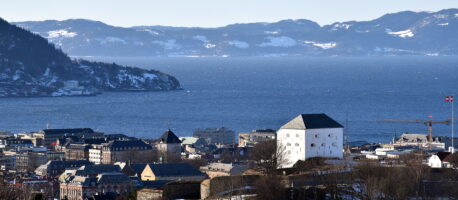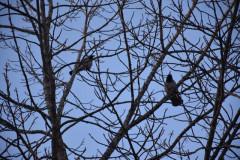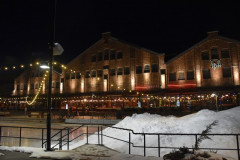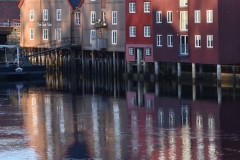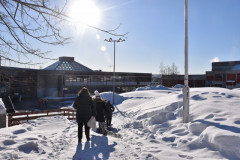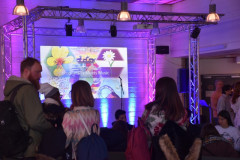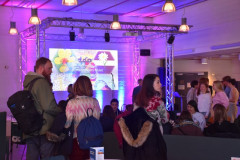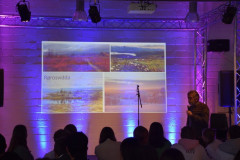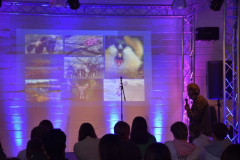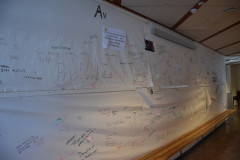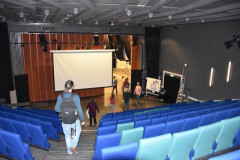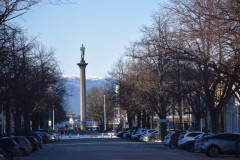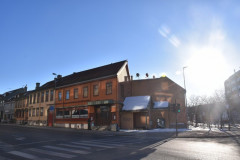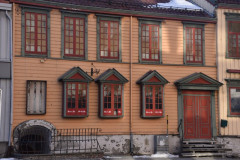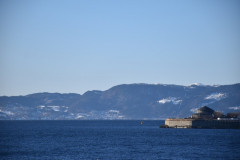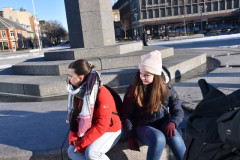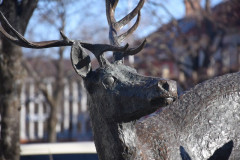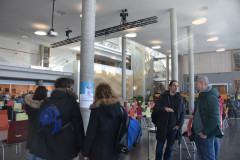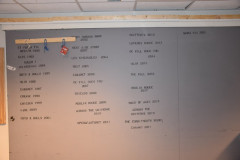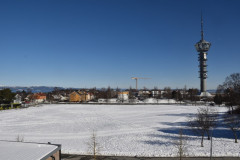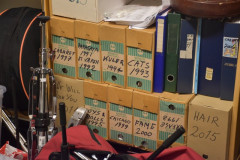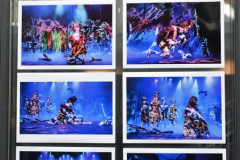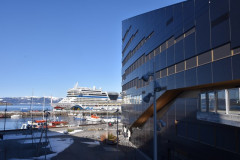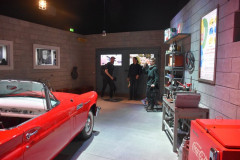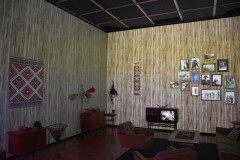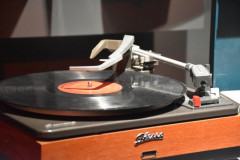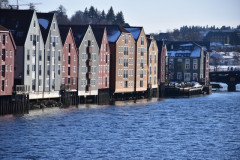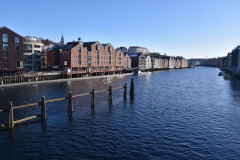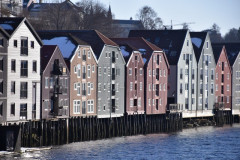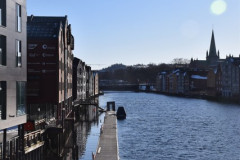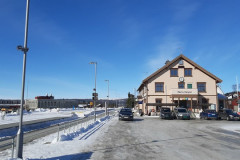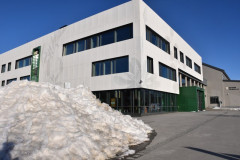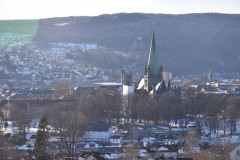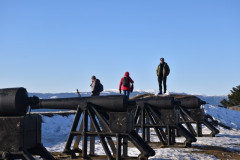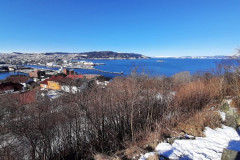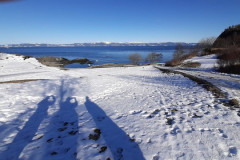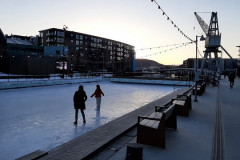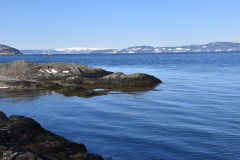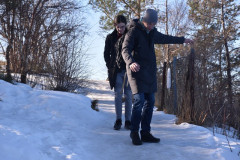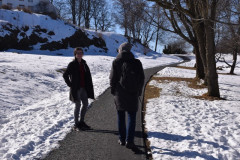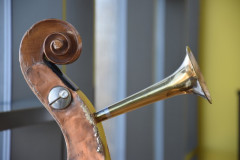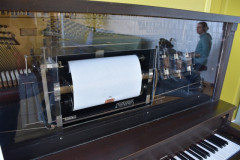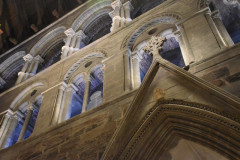Biodiversity meets music – 6th meeting in Trondheim (Trøndelag, Norwegen)
Arrival – 27/03/23

In the last week of school before the Easter holidays, when it felt like half of our school had gone on a trip, the Erasmus group also set off to visit our partners in Trondheim. We met our students in Heerlen at the train station to find out that our train to Utrecht and on to Amsterdam Schiphol only went as far as Eindhoven for some unknown reason. Later we found out that a couple of badgers had undermined the track bed behind Eindhoven – biodiversity says hello! However, we managed to find our way via Rotterdam and boarded our flight to Trondheim without any problems.
We wanted to meet the group from Seville at the gate in Amsterdam – unfortunately they were not there. Later it turned out that they missed the connecting flight and arrived in Trondheim late at night. We were even lucky to use the service of a school bus organised by Stein – one of the coordinators – for the transfer to the hotel “Pilegrimsgården Hotell og Gjestegård” right next to Nidaros Cathedral.
In the evening, we met Magnus, the other coordinator, who welcomed the groups that had already arrived and provided them with first recommendations for dinner and orientation. As our students were in the mood for sushi, we walked through Bakklandet with the teachers from Kissamos and enjoyed a tasty sushi buffet.
On the way back, we teachers stopped at Antikvariatet Pub near the Gamle bybro bridge and enjoyed the excellent live music in the warmth.
The next morning, we met the spanish group at breakfast, but we missed the group from Latvia, who were relocated to the Chesterfield Hotel at the last minute. Without improvisation, such meetings are probably impossible to realise.
Day 1 – 28/03/23 Cissi Klein Day

In the morning, we picked up the Italians in the city in front of their hotel and met the other groups in the centre at Olav Tryggvasons gate to catch the bus to Cissi Klein videregående skole (Upper Secondary School) in the south of the city (Strindheim). It was cold, but the spring sun delighted us with its warming rays.
In 2022, when it opened in temporary premises, the school started with around 200 students from the dance branch of Trondheim Cathedral School and the drama branch of other schools. The school, which will move into new buildings in a couple of years, was included in our Erasmus programme because Stein, who has been involved in the project at Strinda videregående skole from the beginning, has recently started teaching at the school. By the way: the school is named after the Jewish girl Cissi Klein, who was arrested by the state police in the classroom in November 1942 and shortly afterwards deported on the ship “MS Gotenland” from Oslo to Stettin. Together with her father and brother, 13-year-old Cissi was deported to the gas chambers of Auschwitz and murdered. We could not believe that the school buildings were temporary and would even be demolished in a few years and speculated that such buildings would surely be kept in use in Germany for at least another 20 years or more.
We were warmly welcomed by Stein and the headmistress. Afterwards, a biology teacher introduced us on the one hand to what he saw as the modest diversity of species, and on the other hand to the many different ecosystems that Norway includes simply because of its linear expansion.
Afterwards, mixed student groups were set up to exchange ideas about the importance of biodiversity and to work together on making posters with slogans and messages to be displayed in the city the next day. We teachers were given a tour of the school and made aware of the special features – besides the concert hall, the hall of mirrors and numerous rehearsal rooms, we noticed that the students here have many options for decorating their school. We also learned about the pedagogical and organisational working conditions for teachers in the Norwegian school system.
After a joint lunch, to which we were invited by our hosts, the groups of students took turns in workshops on dance, theatre, singing and reflection on biodiversity. Especially the rehearsed Norwegian song “Alle fugler små de er” made us smile, as we knew it very well as the German folk song “Alle Vögel sind schon da”.
Finally, we said goodbye and took the bus back to the city. Until dinner at Olavstorget food court, everyone used the free time to relax individually. After dinner, Magnus and Stein introduced us to their favourite pub at the Nidelva, the river that runs through the city.
Day 2 – 29/03/23 Strinda Day
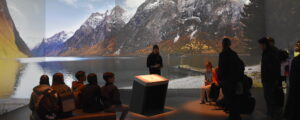
After breakfast, we walked to the central square, Trondheim Torg. At Kongens Gate, we listened to the not always entirely serious stories of Magnus. The Norwegian students distributed the posters in the groups and guided through the city, while at the same time the posters were put up at prominent spots. The teacher group followed their guide Magnus, who, as usual, gave the most important information about the individual sights in a sovereign, short, concise, and funny manner. For example, we were asked, what Bob Dylan was doing on the roof of Nidaros Cathedral. At first, we thought it was a bad joke, but the statue on the top of the north-west tower is, after all, the Archangel Michael. And Nidaros Cathedral is not just any church, but a national shrine, the coronation site of Norwegian kings and an episcopal church. The story mentions that one of the stonemasons who replace destroyed stones and repair figures, as a passionate Bob Dylan fan, is said to have immortalised Bob’s face on the angel figure – allegedly as a protest the armament of nuclear weapons and war.
Later we took the bus up to Tyholt Tower, next to which is Strinda Upper Secondary School, where Magnus teaches. The school has about 1100 students and 170 staff members. The school offers five educational programmes, both academic (physical education, languages, social studies, and business) and vocational (health and social work, restaurant and food programme and electrical engineering). Founded in 1933 and renamed in 1977, the school was expanded in 1979 with a new addition that includes a canteen, library, reading room, large stage, and modern classrooms. In 2011, work began on remodelling the old school buildings in Tyholt, which now gives the buildings a modern look. Very impressive are the annual performances of a newly rehearsed musical for seven consecutive days, involving many students and teachers from the school.
The Erasmus students and teachers were given a tour of the school and were then treated to a traditional salmon dish in the school’s refectory – many thanks for this and for the warm welcome from the headmistress. The chocolate Easter eggs made by the canteen cooks were also delicious.
In the afternoon, we visited the Rockheim Museum located at the harbour. An Aida cruise ship with German tourists had docked in the harbour that day, so we heard a familiar language in many corners of the city. At Rockheim Museum, Norway’s national museum for popular music, we were guided in groups again. The music and the stories surrounding the musicians are conveyed with the help of interactive exhibition technology and objects from the museum’s collections. The “Time Tunnel” represents a journey through modern Norwegian music and cultural history. In these exhibits, visitors can individually control the playback of sounds, images and music videos and thus gain their own access to the popular music of Norway. The Hall of Fame is a facility to honour individuals and groups who have played a significant role in the development and spread of Norwegian pop and rock music.
After a well-deserved rest, we happily spent the evening in a pizzeria in Solsiden and celebrated Thomas´ birthday – for good measure discussing the one or other with the Norwegian coordinators at Dokkhuset.
Day 3 – 30/03/23 Røros Day

We admit, we had respect! Respect for the announced low temperatures in Røros, a town in the south-east of Trondelag. We met at Strinda videregående skole and set off for the 2½-hour bus ride to Røros on time. Røros is one of the coldest places in Norway – the temperature often drops below -30 °C, but we were lucky to catch a relatively warm and sunny day, so that when we arrived the temperatures were in the single-digit minus range and stayed until our return journey.
Røros is an enchanting place with a charm all its own, a mixture of scenes from Astrid Lindgren and Wild West films, in short, a site that is a Unesco World Heritage Site, picturesquely set in a small hollow with arid birch forests and bare fells. The Norwegian writer Johan Falkberget described it as “a place with a whispering history”. The historic copper mining town (which used to be called Bergstad) has beautifully preserved, colourful wooden houses that climb the hillside, as well as fascinating relics from the town’s mining past. After a guided tour of the town, which was taken over by three of Stein’s students who grew up in Røros, those students who have never or rarely seen snow romped in the snow on the artificially created slag heaps.
In former times, the “Malmplass” (engl.: ore square) in front of the smelter was the centre of the village. This is where the delivered ore was weighed and where the bell that rang at the beginning and end of the shift was located – today it is a kind of landmark of the town. The small, flat, and up to 250 years old wooden houses of the simple miners are almost in the shade at the foot of the slag heaps. The rust-red or yellow-painted buildings of the directors, engineers, and civil servants, which are typical of Norway, are to be found further down town. It is said that tourists often see the place as a backdrop, and it has happened that they simply went into the inhabited houses without knocking and were surprised to find themselves in the living room of the residents.
The townscape of Røros is dominated by the white octagonal church from 1784, with the miners’ signs of chisel and mallet on its bell tower. The priest, father of one of the schoolgirls who had guided us through the village, gave us an understanding of the church’s history after we had knocked kindly on the church door. The interior of the church is dominated by open and closed galleries and the royal box. On the walls there are pictures of pastors and mine directors of past centuries. The church also houses a baroque organ, on which the organist played us the folk song “Alle fugler små de er” with variations, again causing smiles among the listeners. After eating packed lunches in the parish hall, we still had a little time to explore the town on our own, pick up some souvenirs or have a hot coffee before heading back to Trondheim in the afternoon.
Not only to stretch our legs, but also to enjoy the unique view of Trondheim, we didn’t take the bus from Strinda back to the city this time, but walked down – past the Kristiansten Festning, which is located on a hill outside the city centre. It was meant to protect the city from attacks and was equipped with several cannons. The most striking part of the fortress is the white donjon, a four-storey tower with embrasures. After the great city fire of Trondheim in 1681, Johan Caspar von Cicignon had built the fortress to repel attacks from the east. The new city bridge over the river Nidelven was built as a connection to the barracks in the city centre. In 1718, the fortress fulfilled its original purpose and protected the city from conquest by the Swedes, with whom it was in conflict at the time. In 1816, however, the bulwark was taken out of service by King Charles XIV John, but the Norwegian army still uses the fortress for exercises today. The view over the city in the light of the setting evening sun is incomparable.
Down at the Gamle bybro, each group went their separate ways to finally meet for “last supper” at the Bror in the evening. After receiving our certificates, we had one last drink and said goodbye.
Even though we (the German team) had one more day to spend in Trondheim before heading home, we wished everyone a safe and pleasant journey back. We would like to thank our hosts Magnus and Stein, their students and all those involved in the background for the unforgettable days with you. We enjoyed the stay with you, we appreciated your hospitality, and we gained valuable new experiences, made new friends, and maintained old ones.
Tag 4 – 31.03.23 Lade Day for German team

We had allowed ourselves a little more sleep and met for the delicious breakfast as always. The day was at leisure. Among the chosen destinations were a waterfall and a lake in the west of the city (Kira and Patricia), the Nidaros Cathedral and the Archbishop’s Palace (Sabrina and Jan), whereas Adrian joined us teachers to hike once around the Lade peninsula in the north-east of the city. We took the bus to Ladehammeren and after a little search we found the path along the fjord shore, which turned out to be quite slippery due to the old and icy snow – well, Magnus warned us. Passing Korsvika beach, we fought our way to Ladekaia, a café that opened for the first day in the year.
After a fall or two, we recovered with coffee and cocoa and then headed to the Ringve Music Museum, which first took us into the world of sound under water in a special exhibition called “Lost Voices”. The 26-channel sound installation by Jana Winderen fitted very well with the theme of the Erasmus project – sound as a source for understanding ecological systems and the impact of humans on the underwater world.
The audience will enjoy a composition created especially for the darkened room, based on underwater sounds from the inner part of the Trondheimfjord, from the Arctic Ocean and from tropical waters. Species living under the water surface such as insects, crustaceans, fish, and mammals navigate, communicate and hunt in various ways using sounds. Human activities interfere with and mask the sounds of wildlife, making it difficult for them to hear each other. Human-made sounds are increasing, while biophony is decreasing. Winderen has composed this sound installation from hundreds of sound recordings amplified by recordings made with hydrophones.
In another part of the museum, older music history is vividly conveyed through a combination of captivating narrations and demonstrations of historical musical instruments – so-called soundtracks. There, we met a friendly and accomplished musician who took us on a journey through music history and played us contemporary pieces on some historical instruments. In a third room, we were able to try out some instruments ourselves, including an automatic piano discovered by Thomas.
After returning to the city centre, we briefly stopped by the local music shop and met up with some of our students for dinner at Una. Finally, we spent the evening with the “Dahls” Brothers at Den Gode Nabo, making some plans for the final concert in May.
Departure – 01/04/23 Nidarosdomen Day

Since we could leave our luggage at the hotel after checking out, we visited the impressive interior of Nidaros Cathedral, including the mighty Steinmeyer organ from 1930 and the Wagner organ from 1741. The visit to the museum of the Archbishop’s Palace is also worthwhile, especially watching an interesting film about the history of the cathedral’s origin and its numerous rebuildings.
However, as we still had to collect the luggage from the hotel and to make our way by bus to the airport, there was little time to enjoy the warming spring sun in the courtyard of the Palais. Only one cinnamon bun was left, then it was off to the bus and to the airport. The rest of the return journey went smoothly, and in the end, we were able to hand over our Erasmus group safely to their parents in Heerlen in the evening. Thanks again for this beautiful and unforgettable week in Trondheim!
R. Ostrowski
Project Coordinator
Other reports:

